The Dynamics of Hongjian Nur, the Largest Desert Freshwater Lake in China, during 1990–2017
Abstract
:1. Introduction
2. Materials
2.1. Study Area
2.2. Materials
- (1)
- Landsat surface reflectance data for 1990–2017 were used to extract the lake areas. Only cloud-free images from April to November were selected to avoid cloud contamination and to exclude periods when the lake was frozen.
- (2)
- The x, y, and z coordinates in WGS84 of two routes around HN were measured with RTK positioning in November 2017 to retrieve the height of the lake surface in different historic periods (Figure 3).
- (3)
- Pan evaporation and precipitation of two nearest meteorological stations (Yulin and Dongsheng) away from the HN basin for 1990–2017 were downloaded from the Greenhouse Data website (http://data.sheshiyuanyi.com/WeatherData/, 15 August 2020). In this study, the mean values of the evaporation and precipitation data of these two meteorological stations are used as the evaporation and precipitation data of the HN Basin.
- (4)
- The data of gross industrial output value and population came from China Statistical Yearbook (volume of towns and villages). The data for agriculture and livestock before 2015 are derived from the literature [18].
3. Methodology
3.1. Water Area Extraction
3.2. Water Level and Storage
3.3. Water Balance
3.4. Statistical Methods
4. Results
4.1. Changes in Water Area, Level and Storage
4.2. The HN Water Balance
5. Discussion
5.1. Driving Factors
5.1.1. Phase I
5.1.2. Phase II
5.1.3. Phase III
5.1.4. Phase IV
5.1.5. Phase V
- According to “The 13th Five-Year Plan” drawn up by the Chinese government, coal consumption will drop from 5.7 billion tons to 3.4 billion tons from 2015 to 2020. Many coal mining-related businesses have had to close or reduce capacity.
- There was of water discharged each year from the Zhashake reservoir and Maogaitu reservoir to the HN after 2015.
5.2. Uncertainties and Limitations
6. Conclusions
Author Contributions
Funding
Conflicts of Interest
References
- Micklin, P. Desiccation of the Aral Sea: A water management disaster in the Soviet Union. Science 1988, 241, 1170–1176. [Google Scholar] [CrossRef] [PubMed] [Green Version]
- Sellinger, C.; Stow, C.; Lamon, E.; Qian, S. Recent water level declines in the Lake Michigan-Huron system. Environ. Sci. Technol. 2008, 42, 367–373. [Google Scholar] [CrossRef]
- Wurtsbaugh, W.A.; Miller, C.; Null, S.E.; DeRose, J.; Wilcock, P.; Hahnenberger, M.; Howe, F.; Moore, J. Decline of the world’s saline lakes. Nat. Geosci. 2017, 10, 816–823. [Google Scholar] [CrossRef]
- Williamson, C.E.; Saros, J.E.; Vincent, W.F.; Smol, J.P. Lakes and reservoirs as sentinels, integrators, and regulators of climate change. Limnol. Oceanogr. 2009, 54, 2273–2282. [Google Scholar] [CrossRef]
- MacDonald, G.M.; Edwards, T.W.D.; Moser, K.A.; Pienitz, R.; Smol, J.P. Rapid response of treeline vegetation and lakes to past climate warming. Nature 1993, 361, 243–246. [Google Scholar] [CrossRef]
- Song, C.; Huang, B.; Ke, L.; Richards, K.S. Seasonal and abrupt changes in the water level of closed lakes on the Tibetan Plateau and implications for climate impacts. J. Hydrol. 2014, 514, 131–144. [Google Scholar] [CrossRef]
- Yuan, Y.; Zeng, G.; Liang, J.; Huang, L.; Hua, S.; Li, F.; Zhu, Y.; Wu, H.; Liu, J.; He, X.; et al. Variation of water level in Dongting Lake over a 50-year period: Implications for the impacts of anthropogenic and climatic factors. J. Hydrol. 2015, 525, 450–455. [Google Scholar] [CrossRef]
- Natugonza, V.; Ogutu-Ohwayo, R.; Musinguzi, L.; Olokotum, M.; Naigaga, S.; Kitabona, J. Implications of climate warming for hydrology and water balance of small shallow lakes: A case of Wamala and Kawi, Uganda. Aquat. Ecosyst. Health Manag. 2016, 19, 327–335. [Google Scholar] [CrossRef]
- Wang, J.; Sheng, Y.; Wada, Y. Little impact of the Three Gorges Dam on recent decadal lake decline across China’s Yangtze Plain. Water Resour. Res. 2017, 3854–3877. [Google Scholar] [CrossRef] [Green Version]
- Francesco, S.D.; Biscarini, C.; Montesarchio, V.; Manciola, P. On the role of hydrological processes on the water balance of Lake Bolsena, Italy. Lakes Reserv. Res. Manag. 2016, 21, 45–55. [Google Scholar] [CrossRef]
- Wang, J.; Song, C.; Reager, J.T.; Yao, F.; Famiglietti, J.S.; Sheng, Y.; MacDonald, G.M.; Brun, F.; Schmied, H.M.; Marston, R.A.; et al. Recent global decline in endorheic basin water storages. Nat. Geosci. 2018, 11, 926–932. [Google Scholar] [CrossRef] [Green Version]
- Cardille, J.A.; Carpenter, S.R.; Coe, M.T.; Foley, J.A.; Hanson, P.C.; Turner, M.G.; Vano, J.A. Carbon and water cycling in lake-rich landscapes: Landscape connections, lake hydrology, and biogeochemistry. J. Geophys. Res. 2007, 112, 1–18. [Google Scholar] [CrossRef] [Green Version]
- Crawford, J.T.; Lottig, N.R.; Stanley, E.H.; Walker, J.F.; Hanson, P.C.; Finlay, J.C.; Striegl, R.G. CO2 and CH4 emissions from streams in a lake-rich landscape: Patterns, controls, and regional significance. Glob. Biogeochem. Cycles 2014, 28, 197–210. [Google Scholar] [CrossRef]
- El-Zehairy, A.A.; Lubczynski, M.W.; Gurwin, J. Interactions of artificial lakes with groundwater applying an integrated MODFLOW solution. Hydrogeol. J. 2018, 26, 109–132. [Google Scholar] [CrossRef]
- Liu, H.; Yin, Y.; Piao, S.; Zhao, F.; Engels, M.; Ciais, P. Disappearing Lakes in Semiarid Northern China: Drivers and Environmental Impact. Environ. Sci. Technol. 2013, 47, 12107–12114. [Google Scholar] [CrossRef]
- Tao, S.; Fang, J.; Zhao, X.; Zhao, S.; Shen, H.; Hu, H.; Tang, Z.; Wang, Z.; Guo, Q. Rapid loss of lakes on the Mongolian Plateau. Proc. Natl. Acad. Sci. USA 2015, 112, 2281–2286. [Google Scholar] [CrossRef] [Green Version]
- Tan, L.; Zhang, H.; Zhang, R.; Luo, z.; Li, X.; Liu, P. Study on landscape pattern change of Hongjian Lake basin in northern Shaanxi province, China. J. Xian Jiaotong Univ. 2010, 44, 126–132. [Google Scholar]
- Liang, K.; Yan, G. Application of Landsat Imagery to Investigate Lake Area Variations and Relict Gull Habitat in Hongjian Lake, Ordos Plateau, China. Remote Sens. 2017, 9, 1019. [Google Scholar] [CrossRef] [Green Version]
- Song, C.; Huang, B.; Ke, L. Modeling and analysis of lake water storage changes on the Tibetan Plateau using multi-mission satellite data. Remote Sens. Environ. 2013, 135, 25–35. [Google Scholar] [CrossRef]
- Song, C.; Huang, B.; Richards, K.; Ke, L.; Phan, V.H. Accelerated lake expansion on the tibetan plateau in the 2000s: Induced by glacial melting or other processes? Water Resour. Res. 2014, 50, 3170–3186. [Google Scholar] [CrossRef] [Green Version]
- Song, C.Q.; Ye, Q.H.; Cheng, X. Shifts in water-level variation of Namco in the central Tibetan Plateau from ICESat and CryoSat-2 altimetry and station observations. Sci. Bull. 2015, 60, 1287–1297. [Google Scholar] [CrossRef] [Green Version]
- Smith, L.C.; Sheng, Y.; MacDonald, G.M.; Hinzman, L.D. Disappearing Arctic Lakes. Science 2005, 308, 1429. [Google Scholar] [CrossRef] [Green Version]
- Wang, J.; Sheng, Y.; Tong, T.S.D. Monitoring decadal lake dynamics across the Yangtze Basin downstream of Three Gorges Dam. Remote Sens. Environ. 2014, 152, 251–269. [Google Scholar] [CrossRef]
- Yang, K.; Yao, F.; Wang, J.; Luo, J.; Shen, Z.; Wang, C.; Song, C. Recent dynamics of alpine lakes on the endorheic Changtang Plateau from multi-mission satellite data. J. Hydrol. 2017, 552, 633–645. [Google Scholar] [CrossRef]
- Deng-ke, L.; Jing, Z.; Zhao, W. Effect of Human Activities and Climate Change on the Water Surface Area of Hongjiannao Lake. J. Glaciol. Geocryol. 2009, 31, 1110–1115. [Google Scholar]
- Yin, L.; Zhang, M.; Dong, J. Area variation and controlling factors of Lake Hongjian, Mu Us desert, China based on remote sensing techniques. Geol. Bull. China 2008, 27, 1151–1156. [Google Scholar] [CrossRef]
- Li, B.; Yu, Z.; Liang, Z.; Acharya, K. Hydrologic response of a high altitude glacierized basin in the central Tibetan Plateau. Glob. Planet. Chang. 2014, 118, 69–84. [Google Scholar] [CrossRef]
- Ying, L.; Li-xin, W.; Hui, Y. Monitoring of Hongjiannao Lake Area Based on landsat and HJ Imageries. Geogr. Geo-Inf. Sci. 2015, 31, 60–64. [Google Scholar] [CrossRef]
- Ying, L.; Hui, Y. Analysis of Hongjiannao Lake Area Based on SMMI. Sci. Technol. Eng. 2016, 16, 122–127. [Google Scholar]
- Zhang, G.; Xie, H.; Kang, S.; Yi, D.; Ackley, S.F. Monitoring lake level changes on the Tibetan Plateau using ICESat altimetry data (2003–2009). Remote Sens. Environ. 2011, 115, 1733–1742. [Google Scholar] [CrossRef]
- Kropácek, J.; Braun, A.; Kang, S.; Feng, C.; Ye, Q.; Hochschild, V. Analysis of lake level changes in Nam Co in central Tibet utilizing synergistic satellite altimetry and optical imagery. Int. J. Appl. Earth Obs. Geoinf. 2012, 17, 3–11. [Google Scholar] [CrossRef]
- Singh, A.; Seitz, F.; Schwatke, C. Inter-annual water storage changes in the Aral Sea from multi-mission satellite altimetry, optical remote sensing, and GRACE satellite gravimetry. Remote Sens. Environ. 2012, 123, 187–195. [Google Scholar] [CrossRef]
- Deus, D.; Gloaguen, R.; Krause, P. Water Balance Modeling in a Semi-Arid Environment with Limited in situ Data Using Remote Sensing in Lake Manyara, East African Rift, Tanzania. Remote Sens. 2013, 5, 1651–1680. [Google Scholar] [CrossRef] [Green Version]
- Duan, Z.; Bastiaanssen, W.G.M. Estimating water volume variations in lakes and reservoirs from four operational satellite altimetry databases and satellite imagery data. Remote Sens. Environ. 2013, 135, 403–416. [Google Scholar] [CrossRef]
- Tong, X.; Pan, H.; Xie, H.; Xu, X.; Li, F.; Chen, L.; Luo, X.; Liu, S.; Chen, P.; Jin, Y. Estimating water volume variations in Lake Victoria over the past 22 years using multi-mission altimetry and remotely sensed images. Remote Sens. Environ. 2016, 187, 400–413. [Google Scholar] [CrossRef]
- Zhu, W.; Yan, J.; Jia, S. Monitoring Recent Fluctuations of the Southern Pool of Lake Chad Using Multiple Remote Sensing Data: Implications for Water Balance Analysis. Remote Sens. 2017, 9, 1032. [Google Scholar] [CrossRef] [Green Version]
- Crétaux, J.-F.; Abarca-del-Río, R.; Bergé-Nguyen, M.; Arsen, A.; Drolon, V.; Clos, G.; Maisongrande, P. Lake Volume Monitoring from Space. Surv. Geophys. 2016, 37, 269–305. [Google Scholar] [CrossRef] [Green Version]
- Badulin, S.; Zinchenko, V.; Belonenko, T. Altimetry for the future: Building on 25 years of progress. Adv. Space Res. 2021. [Google Scholar] [CrossRef]
- Cai, X.; Gan, W.; Ji, W.; Zhao, X.; Wang, X.; Chen, X. Optimizing Remote Sensing-Based Level-Area Modeling of Large Lake Wetlands: Case Study of Poyang Lake. IEEE J. Sel. Top. Appl. Earth Obs. Remote Sens. 2015, 8, 471–479. [Google Scholar] [CrossRef]
- Smith, L.C.; Pavelsky, T.M. Remote sensing of volumetric storage changes in lakes. Earth Surf. Process. Landf. 2009, 34, 1353–1358. [Google Scholar] [CrossRef]
- Yang, C.; Cai, X.; Wang, X. Remote Sensing of Hydrological Changes in Tian-e-Zhou Oxbow Lake, an Ungauged Area of the Yangtze River Basin. Remote Sens. 2018, 10, 27. [Google Scholar] [CrossRef] [Green Version]
- Pan, F.; Liao, J.; Li, X.; Guo, H. Application of the inundation area—lake level rating curves constructed from the SRTM DEM to retrieving lake levels from satellite measured inundation areas. Comput. Geosci. 2013, 52, 168–176. [Google Scholar] [CrossRef]
- Hu, C. A novel ocean color index to detect floating algae in the global oceans. Remote Sens. Environ. 2009, 113, 2118–2129. [Google Scholar] [CrossRef]
- Shen, J.; Wang, Y.; Yang, X.; Zhang, E.; Yang, B.; Junfeng, J.I. Paleosandstorm characteristics and lake evolution history deduced from investigation on lacustrine sediments--The case of Hongjiannao Lake, Shaanxi Province. Sci. Bull. 2005, 50, 2355–2361. [Google Scholar] [CrossRef]
- Ma, B.; Wu, L.; Zhang, X.; Li, X.; Liu, Y.; Wang, S. Locally adaptive unmixing method for lake-water area extraction based on MODIS 250 m bands. Int. J. Appl. Earth Obs. Geoinf. 2014, 33, 109–118. [Google Scholar] [CrossRef]
- Feng, L.; Hu, C.M.; Chen, X.L.; Cai, X.B.; Tian, L.Q.; Gan, W.X. Assessment of inundation changes of Poyang Lake using MODIS observations between 2000 and 2010. Remote Sens. Environ. 2012, 121, 80–92. [Google Scholar] [CrossRef]
- Feng, L.; Hu, C.; Chen, X.; Zhao, X. Dramatic inundation changes of China’s two largest freshwater lakes linked to the Three Gorges Dam. Environ. Sci. Technol. 2013, 47, 9628–9634. [Google Scholar] [CrossRef]
- Xing, Q.; Hu, C. Mapping macroalgal blooms in the Yellow Sea and East China Sea using HJ-1 and Landsat data: Application of a virtual baseline reflectance height technique. Remote Sens. Environ. 2016, 178, 113–126. [Google Scholar] [CrossRef]
- Hsieh, P.-F.; Lee, L.C.; Chen, N.-Y. Effect of Spatial Resolution on Classification Errors of Pure and Mixed Pixels in Remote Sensing. IEEE Trans. Geosci. Remote Sens. 2001, 39, 2657–2663. [Google Scholar] [CrossRef]
- Shen, X.; Ouyang, Z.; de Leeuw, J. Constructing a DEM of Baiyang Lake Area from a series of Landsat Images. Geogr. Geo-Inf. Sci. 2005, 21, 16–19. [Google Scholar] [CrossRef]
- Vincent, L. Morphological grayscale reconstruction in image analysis: Applications and efficient algorithms. IEEE Trans. Image Processing 1993, 2, 176–201. [Google Scholar] [CrossRef] [Green Version]
- Long-bin, L.; Qiang, F.; Jin-bai, H. Runoff Conditions and Runoff Coefficient of the wind-water Erosion Crisscross Region on the Northern Loess Plateau. Res. Soiland Water Conserv. 2013, 20, 17–23. [Google Scholar]
- Chen, H.; Wang, Y.; Yang, L.; Gong, H. Economic development and water demand prediction in northwest China. Yellow River 2002, 24, 15–16. [Google Scholar] [CrossRef]
- Mislick, G.K.; Nussbaum, D.A. Linear Regression Analysis; World Scientific: Singapore, 2015. [Google Scholar]
- Qiang, D. Study on Water Environment of Lake in Arid and Semi-arid Areas in Northwest China—A Case Study of Hongjiannao in Shanxi Province; North West University: Xi’an, China, 2017. [Google Scholar]
- Liu, P.; Gan, W.; Zhang, R.f. Quantitative analysis on water volume change and impacting factors for Hongjiannao watershed in northern Shaanxi province. J. Xi’an Jiaotong Univ. 2009, 43, 119–124. [Google Scholar] [CrossRef]
- Li, L. Study on the Environmental Carrying Capacity of Jurassic Coalfield in Northern Shananxi Province; Xi’an University of Technology: Xi’an, China, 2008. [Google Scholar]
- Xueya, D.; Maosheng, Z.; Ying, D. Research on protection and exploitation of groundwater resources in Northern Shaanxi Jurassic Coalfield. Earth Sci. Front. 2010, 17, 200–207. [Google Scholar]
- Zhang, B.; Zhang, J. Coal mining destruction of ecological balance and compensation mechanism in Northern Shaanxi energy and industry base. Coal Geol. China 2010, 22, 38–43. [Google Scholar]
- Xiufen, M.; Lijuan, Z.; Yaojun, F.; Yanbo, T.; Qiming, L.; Jian, M.; Jinxia, M.; Yan, L. A Study on Aquifers and Their Protection in Ordos Basin Coal Base. Coal Geol. China 2012, 24, 36–42. [Google Scholar] [CrossRef]
- Lyons, E.A.; Sheng, Y.; Smith, L.C.; Li, J.; Hinkel, K.M.; Lenters, J.D.; Wang, J. Quantifying sources of error in multitemporal multisensor lake mapping. Int. J. Remote Sens. 2013, 34, 7887–7905. [Google Scholar] [CrossRef]



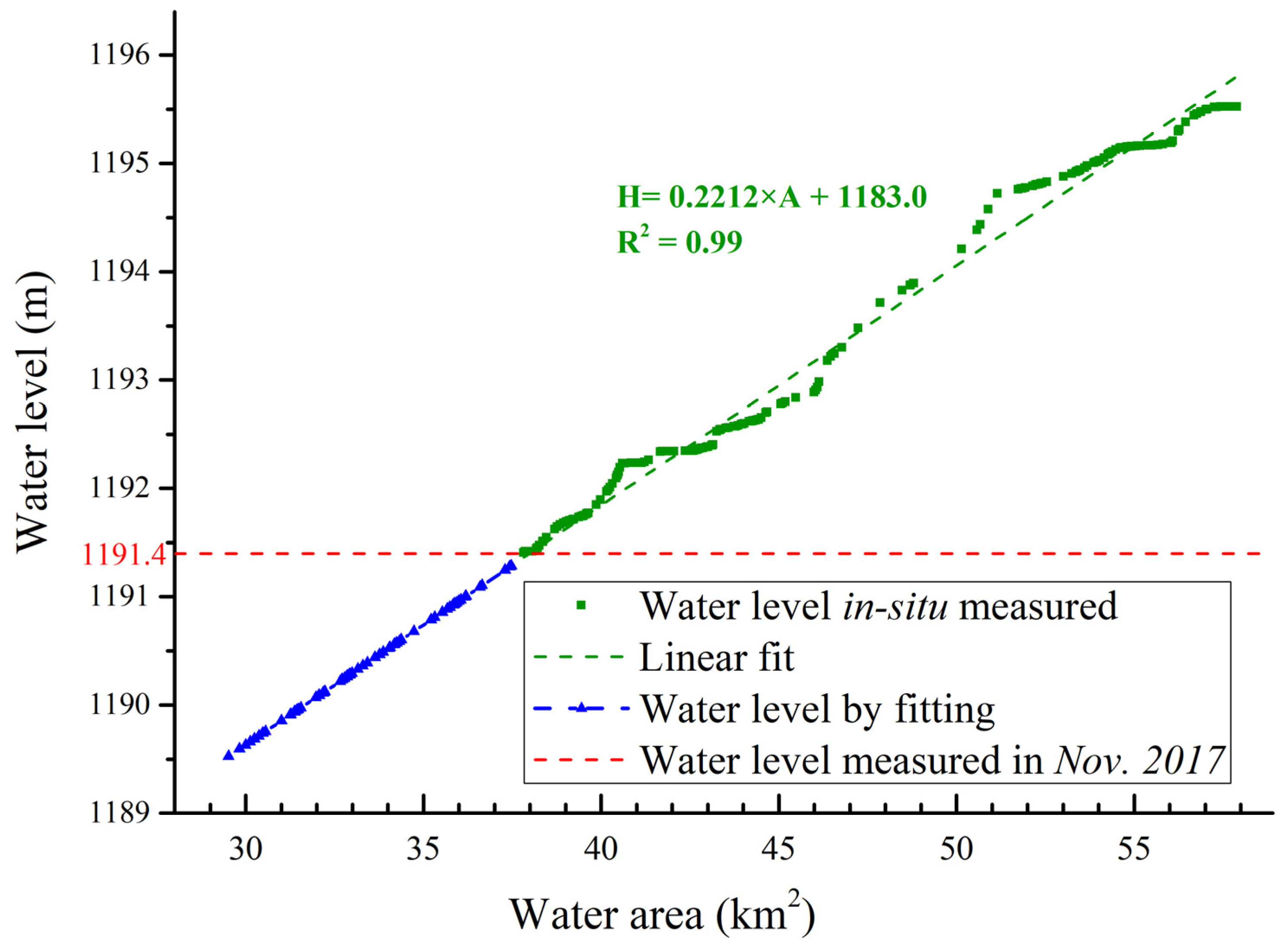
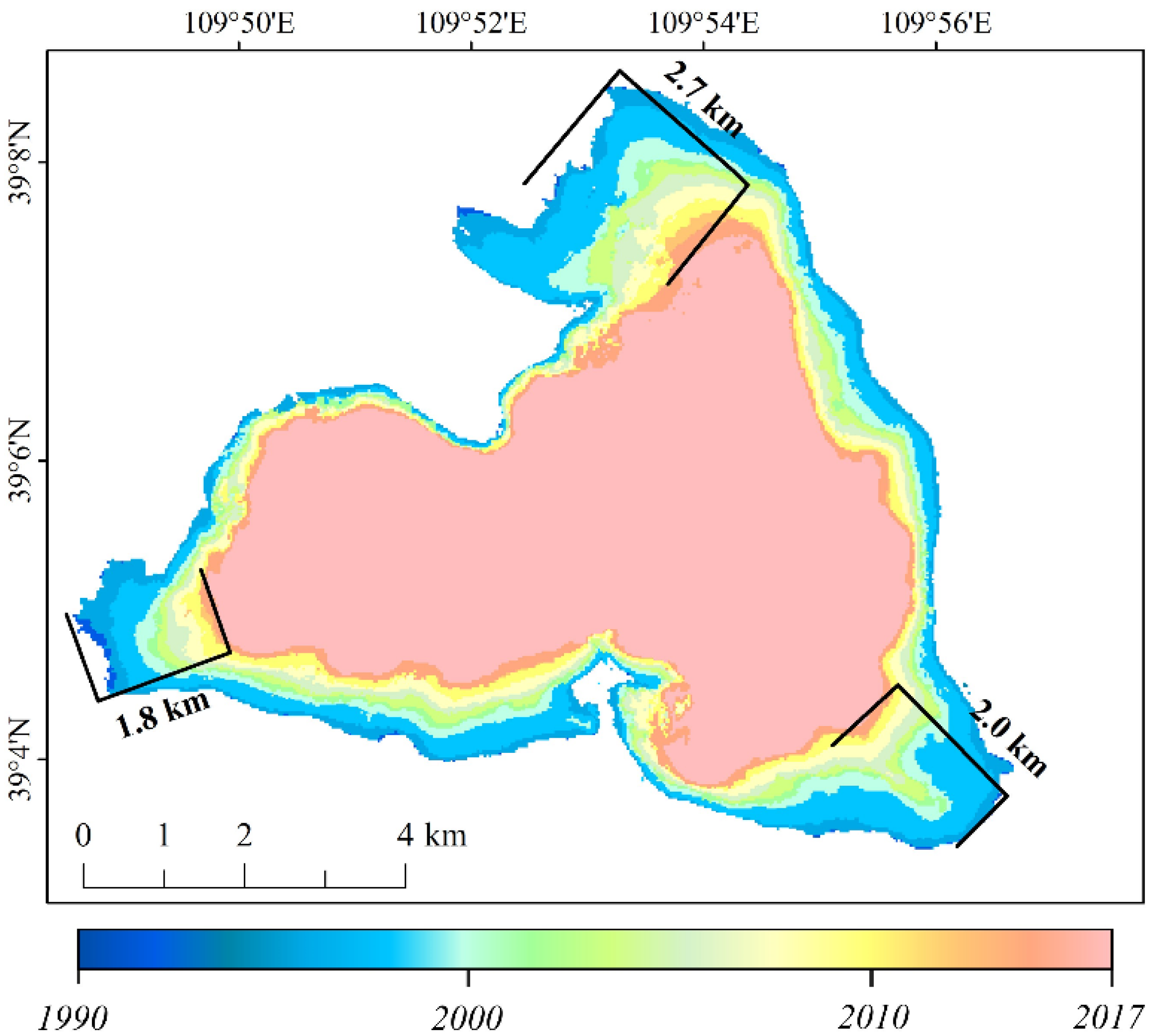
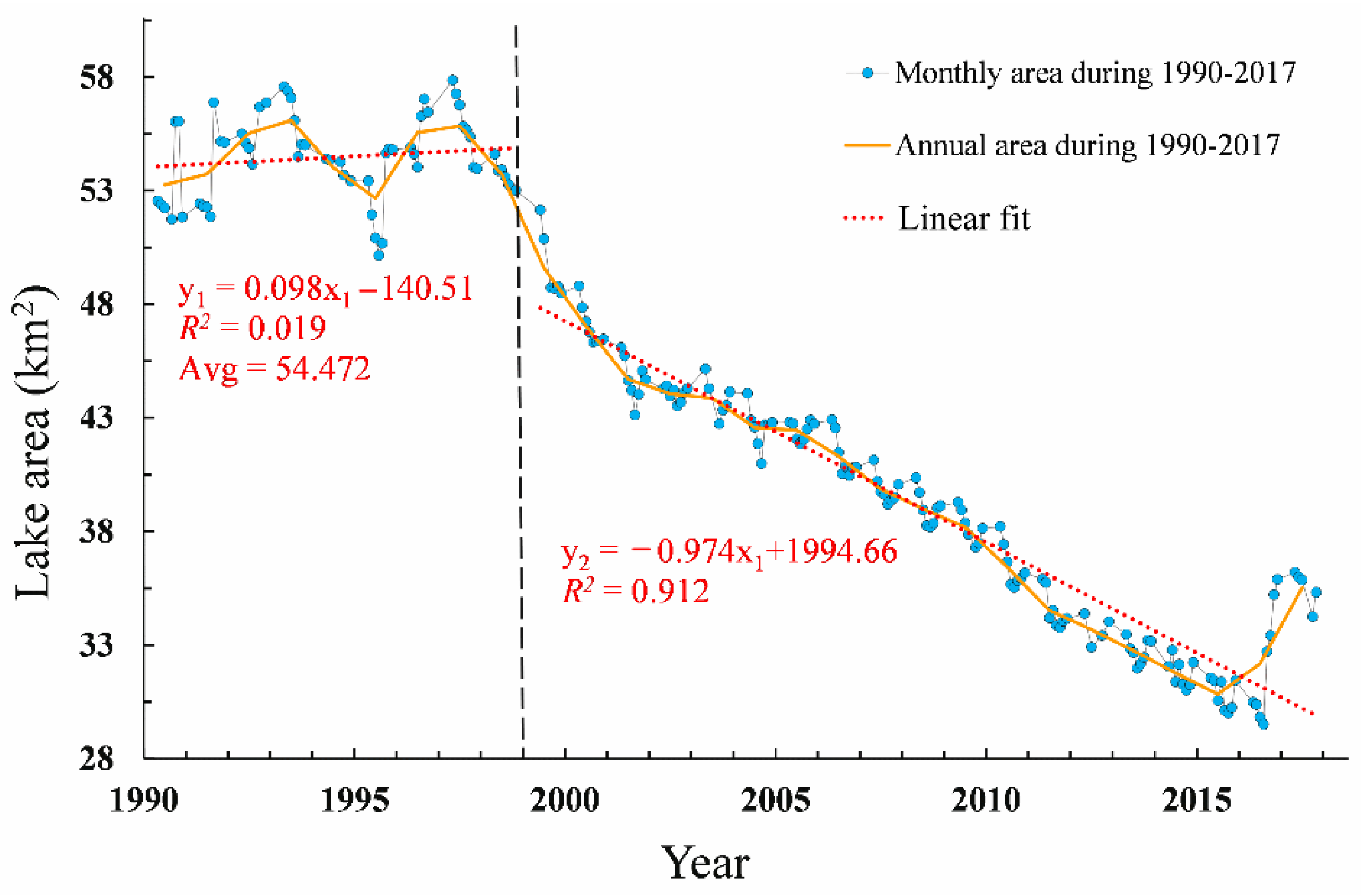
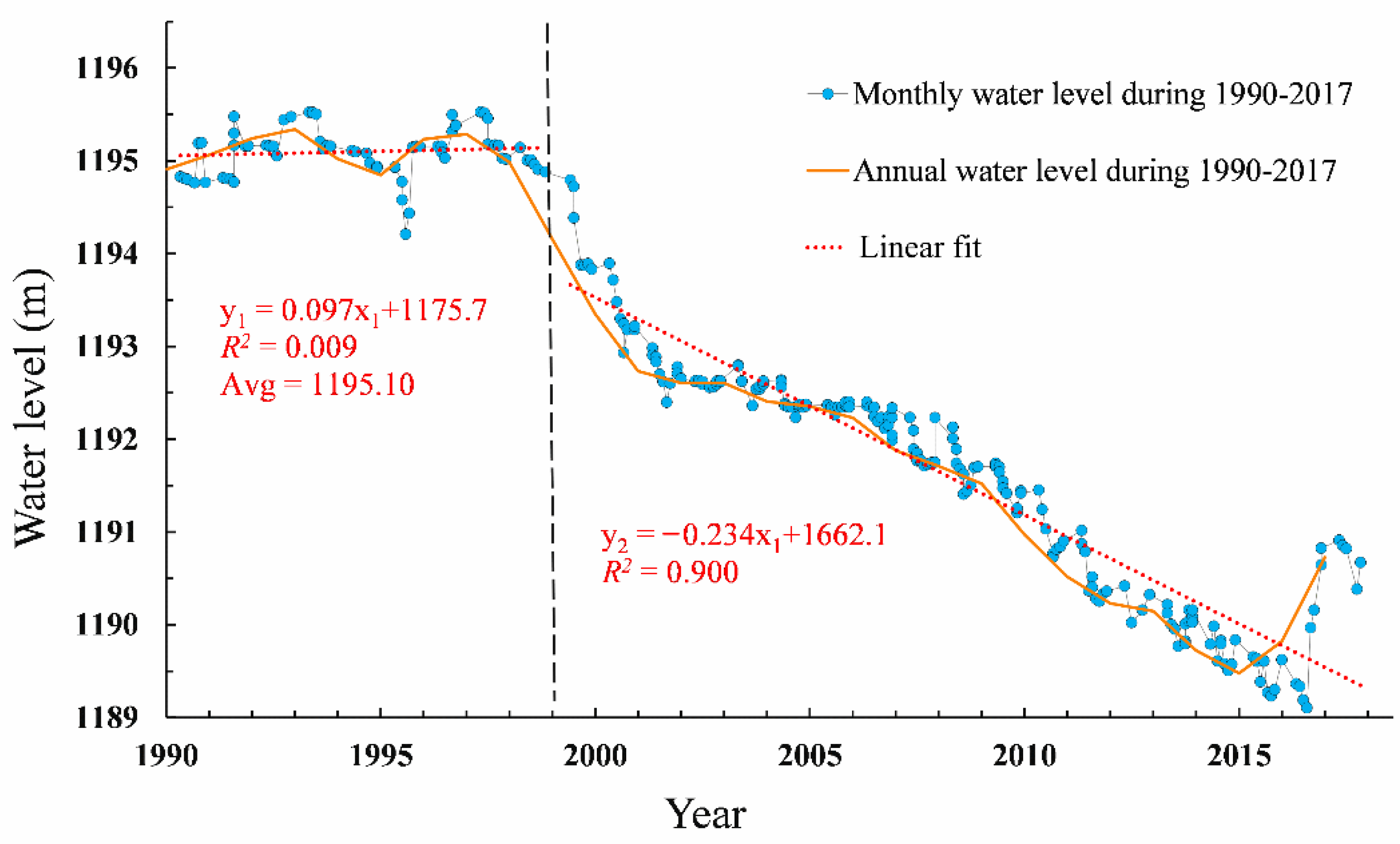
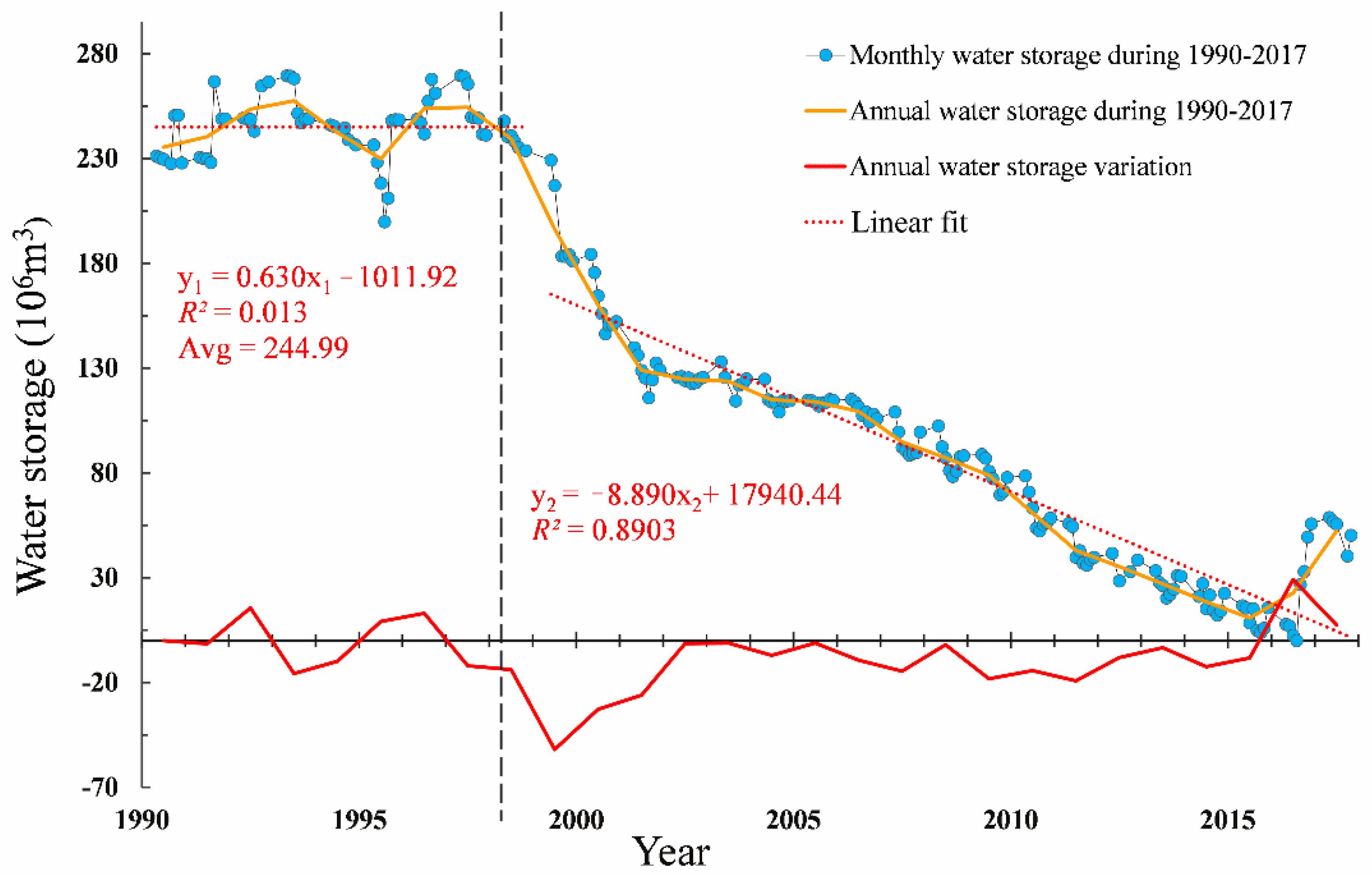

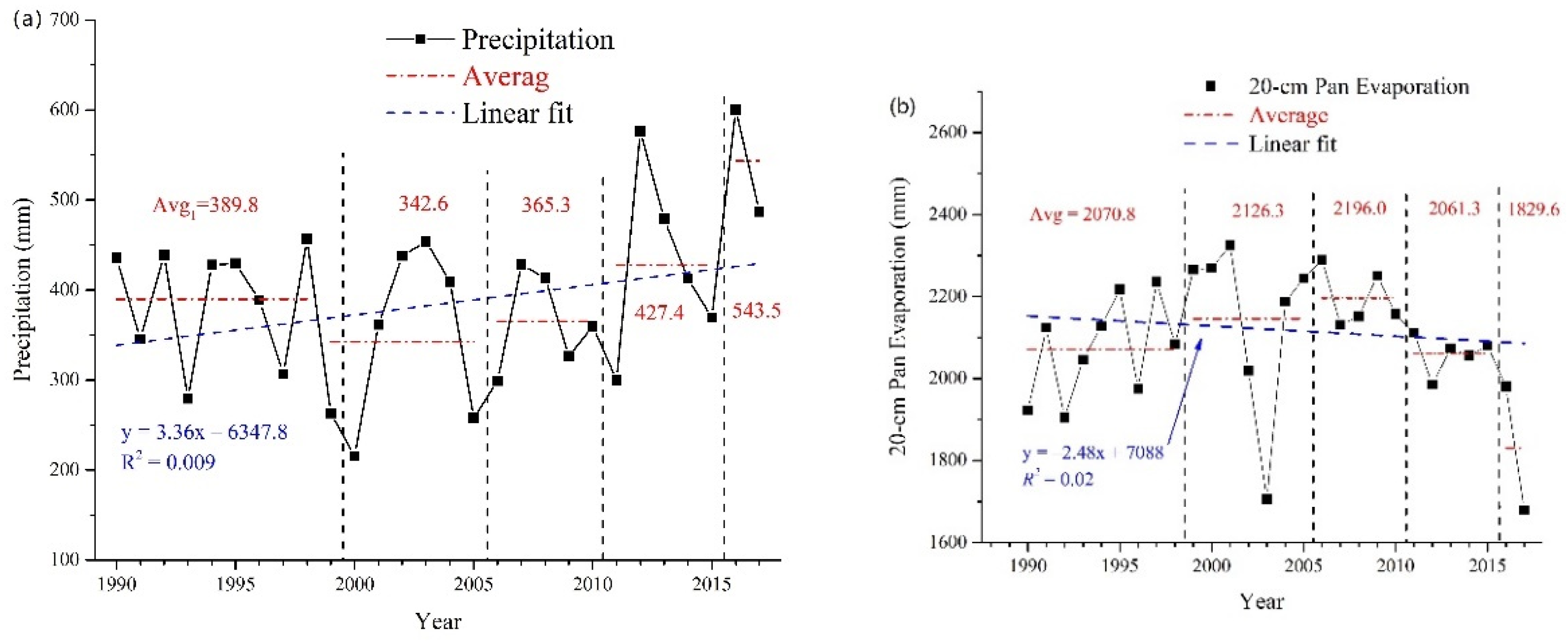
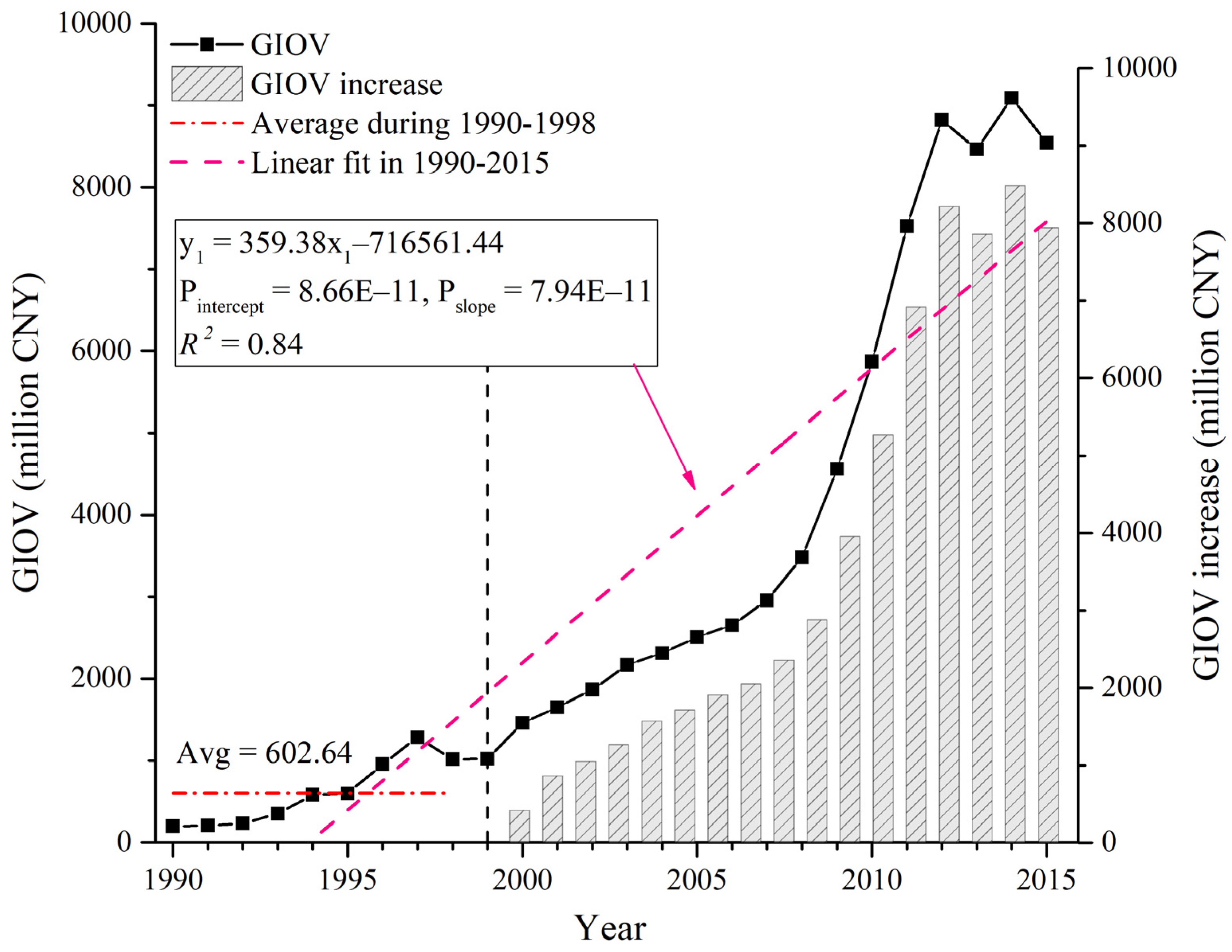
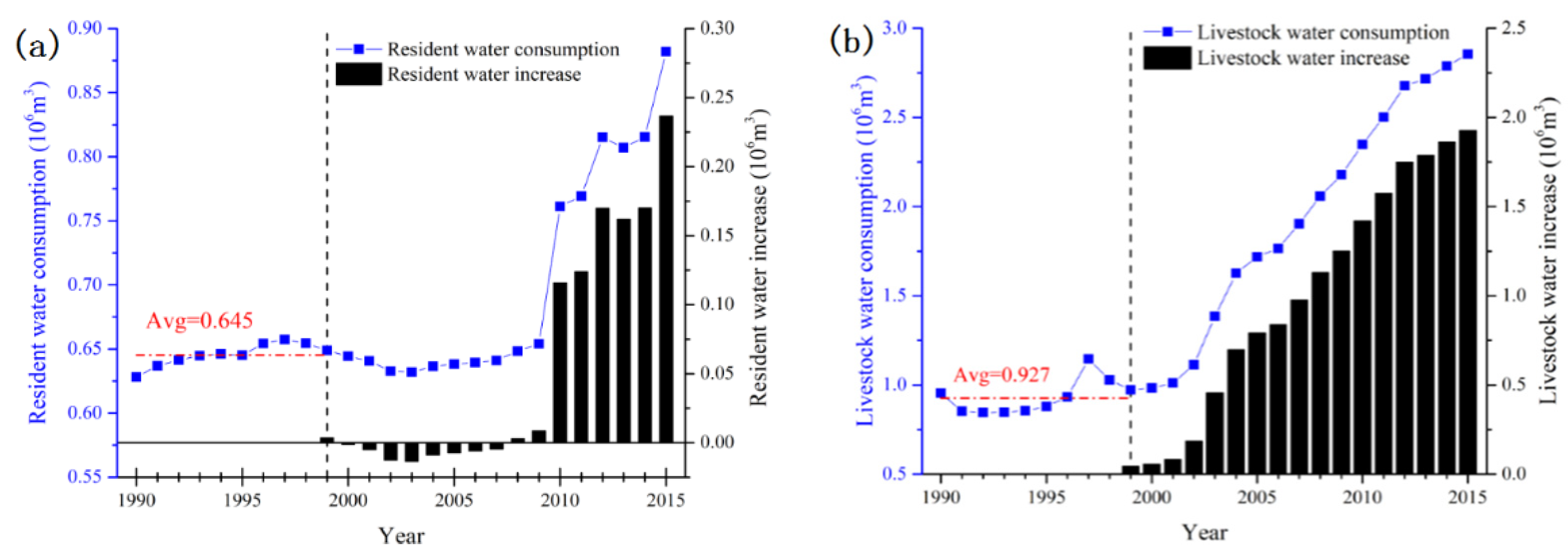
| Water Balance Components | 1990–1998 | 1999–2005 | 2006–2010 | 2011–2015 | 2016–2017 | |
|---|---|---|---|---|---|---|
| Annual Average | Annual Average | Annual Average | Annual Average | Annual Average | ||
| Lake water supply | 56.2 | 49.8 | 53.3 | 62.7 | 79.8 | |
| 21.2 | 15.4 | 14.3 | 14.1 | 18.3 | ||
| 6.67 | 6.67 | 6.67 | 6.67 | 6.67 | ||
| Loss of lake water | 37.1 | 47.2 | 48.7 | 64.3 | 59.8 | |
| 48.5 | 41.8 | 37.2 | 29.2 | 26.5 | ||
| * | −1.53 | −17.13 | −11.63 | −10.03 | +18.47 | |
| P | ET_PAN | RC | LC | GIOV | |
|---|---|---|---|---|---|
| HN volume 1990–2015 | −0.11 | −0.09 | −0.69 | −0.92 | −0.89 |
| HN volume 1990–1998 | −0.11 | −0.55 | −0.16 | −0.23 | −0.25 |
| HN volume 1999–2005 | −0.56 | 0.31 | 0.84 | −0.68 | −0.91 |
| HN volume 2006–2010 | −0.02 | 0.32 | −0.82 | −0.98 | −0.98 |
| HN volume 2011–2015 | 0.08 | 0.00 | −0.89 | −0.95 | −0.61 |
Publisher’s Note: MDPI stays neutral with regard to jurisdictional claims in published maps and institutional affiliations. |
© 2021 by the authors. Licensee MDPI, Basel, Switzerland. This article is an open access article distributed under the terms and conditions of the Creative Commons Attribution (CC BY) license (https://creativecommons.org/licenses/by/4.0/).
Share and Cite
Jiang, Z.; Feng, L.; Li, S.; Wang, J.; Cai, X.; Lin, P.; Wang, X.; Zhao, H. The Dynamics of Hongjian Nur, the Largest Desert Freshwater Lake in China, during 1990–2017. Remote Sens. 2021, 13, 2690. https://doi.org/10.3390/rs13142690
Jiang Z, Feng L, Li S, Wang J, Cai X, Lin P, Wang X, Zhao H. The Dynamics of Hongjian Nur, the Largest Desert Freshwater Lake in China, during 1990–2017. Remote Sensing. 2021; 13(14):2690. https://doi.org/10.3390/rs13142690
Chicago/Turabian StyleJiang, Zhiyong, Lian Feng, Sen Li, Jida Wang, Xiaobin Cai, Peirong Lin, Xiaoyan Wang, and Hongmei Zhao. 2021. "The Dynamics of Hongjian Nur, the Largest Desert Freshwater Lake in China, during 1990–2017" Remote Sensing 13, no. 14: 2690. https://doi.org/10.3390/rs13142690








